Archive for the 'Flowers' Category
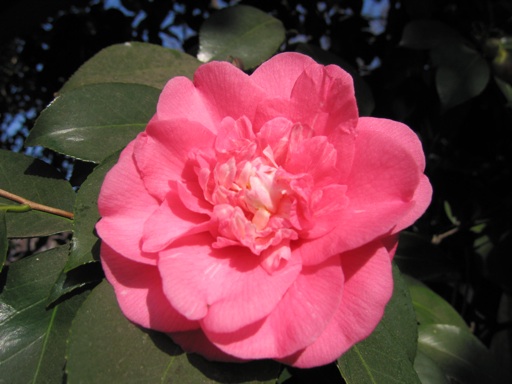
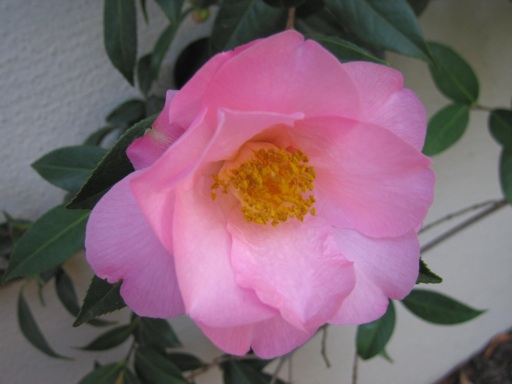
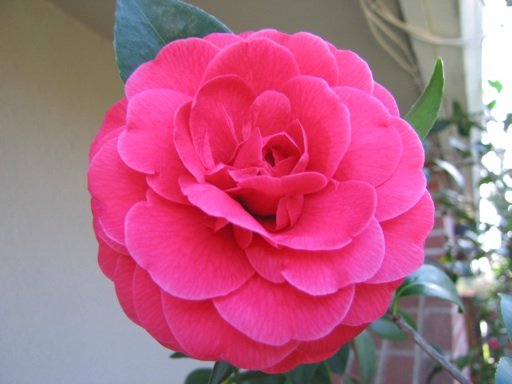
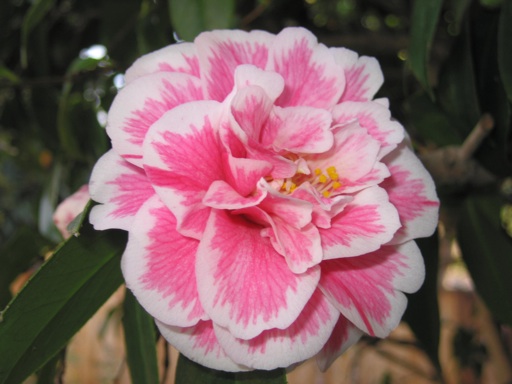
The previous owners of our house planted several camellia bushes next to the house. They look to be at least a few decades old. We are now enjoying the benefits as they begin blooming for another season.
Our camellias typically start blooming in January and continue through April. Camellias are one of my favorite flowers. They make great backyard landscaping plants for the appropriate climate. Even after blooming, their glossy attractive evergreen leaves keep them looking good throughout the summer and fall months.
The high temperatures here have been in the upper 60s and low 70s F for over a week now. Normally, the high temperatures here in January are in the 50s. Several of our camellias have started to open their first sets of flowers in the last few days, as shown in these pictures. The warm weather seems to be the cause.
Camellias prefer a shady location. Luckily, our camellias were astutely planted on the north-east and north-west sides of the house, where they only receive a minimal amount of direct sunlight. They are taller than the house now, and their top branches receive sunlight most of the day. But they don’t seem to mind as long as their lower branches are shaded.
The camellias in the the first, third, and fourth pictures above are most likely camellia japonicas. My best guess is that the camellia in the first picture is Faith Variegated, and the camellia in the fourth picture is Jordan’s Pride. I’m not sure what the others are.
January 18 2009 | Camellias | Comments Off on Camellias in January
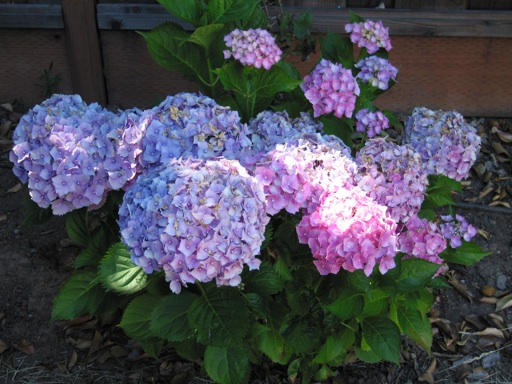
This time of year there’s not much fruiting or blooming in our yard. The few plants that are blooming are not exactly photogenic. So I included some photos of a few of the bigleaf/garden hydrangeas that were blooming in our yard last summer.
Hydrangeas must be one of the most beautiful of garden flowers. Their eye-catching mass of colorful flowers last for weeks in June and July before fading gradually, or more suddenly when a heat wave hits.
When the inevitable heat wave occurs our area in June or July, our bigleaf hydrangeas wilt badly. Every time it happens, I water them excessively to rejuvenate them, but they never fully recover their original beauty. Instead, the flowers and leaves get burnt edges that get larger with each additional hot spell, as shown in the above picture of one of our hydrangeas taken back on June 22. Even under typical weather conditions, hydrangeas need a lot more water than most of our garden plants.
But during hot weather (90s F), I have not been able to prevent them from wilting. I have transplanted most of our hydrangeas from partly shady locations into the few locations in our yard that receive shade nearly all day long. The hydrangeas growing in the shade still wilt in hot weather, but not as severely, even though they are being watered daily. I am coming to the conclusion that bigleaf hydrangeas are not ideally suited to our climate despite the fact that the average high temperature in the summertime here is only in the upper 70s F. Despite the wilting, I like hydrangeas so much that I keep them anyway.
One of the interesting things about hydrangeas is that the flowers never seem to fall off. The color just fades to gray or brown over a period of months. Even in December, our hydrangeas still have flowers on them, but they are unattractive looking. The two pictures below show one of our purple hydrangeas. I took the first picture on July 4, and I took the second picture today, December 14. It’s amazing that the flowers have managed to retain most of their shape after so long.
For me, winter gardening consists mainly of tasks to prepare for spring. One of the tasks I perform each winter is to cut off the stems of all of the bigleaf hydrangeas flowers that bloomed last summer. I have heard repeatedly from other gardeners that bigleaf hydrangeas must be pruned each winter to remove the old dead flowers, otherwise they won’t bloom next season. I haven’t put that idea to test yet to see if failing to prune really does prevent them from flowering. I figure that cutting off the old flowers is probably a good idea anyway just to make the plant look better and to stimulate new growth next season.
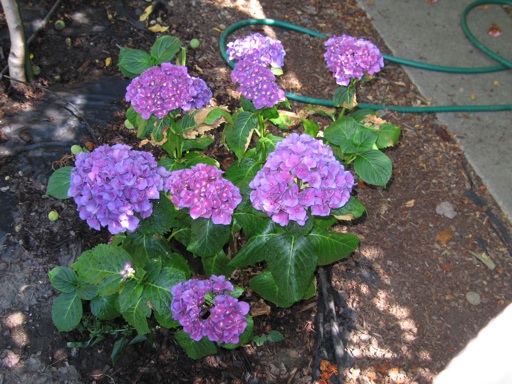

December 14 2008 | Hydrangeas | Comments Off on Thinking of Bigleaf Hydrangeas
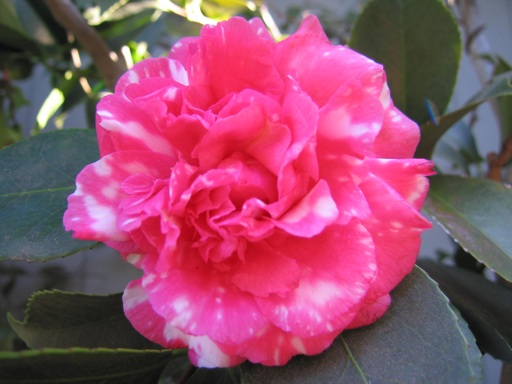
These pictures show some of the first camellia blooms in our yard this season. We have nine camellia bushes in our yard. All of them except one were planted by previous owners of the house. A few of ours have very large trunks and look like they could be as much as 50 years old. Camellias can have a very long lifespan. Some have lived 100 years or more.
The particular camellia in these pictures looks to be about 20-25 years old. It is definitely a camellia japonica, but I am not sure what particular type of japonica it is. My best guess is that it is a Louise Hairston Variegated, a variety that was developed in the USA in 1967.
Camellias are gorgeous flowers. When one is in full bloom, a large plant can be covered with hundreds of flowers, each a few inches in diameter. Camellias also have glossy dark evergreen leaves that are attractive all year long. They come in a huge variety of shapes, although nearly all camellias are red, pink, white, or a combination thereof. One of the best things about camellias is the fact that they flower during cool weather. In general, camellias flower from October through April. Most of the camellia japonicas in our area (USDA zone 9) bloom from January through March. They are one of the few plants we have that bloom in the winter months.
Camellias are popular plants in our neighborhood. Nearly every yard has at least one. They add color to the neighborhood during the colder months, and their foliage remains attractive during the warmer months.
Camellias prefer a shady location. Most of our camellias are planted on the northeast and northwest sides of our house. Some of our camellias have grown higher than the roof line, and as a result, the top branches receive sun most of the day. But they don’t seem to mind as long as the roots and lower branches are shaded.
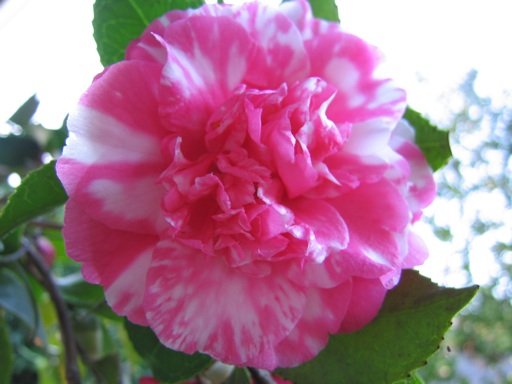
November 29 2008 | Camellias | Comments Off on First Camellia Flowers of the Season
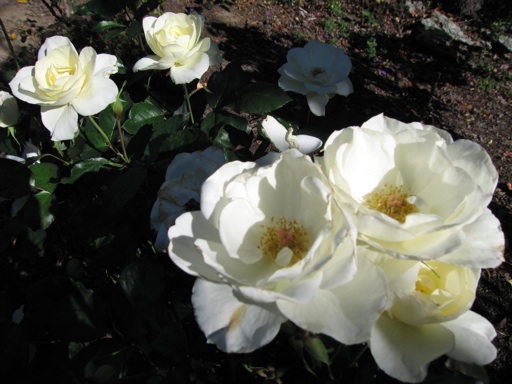
I planted this white simplicity rose in our garden about 5 years ago as a bare root rose along with yellow and pink simplicity bare root roses. The pink simplicity roses grew but never bloomed. After about 3 years without a single flower, I pulled them up. The yellow simplicity rose blooms, but it doesn’t impress visually in terms of both its leaves and flowers. It doesn’t get many flowers, and the flowers it does get lose their petals quickly. Its leaves seem to have gotten infected with some kind of fungus. I plan to pull it up this winter and replace it with a different variety.
On the other hand, the white simplicity rose has grown and bloomed beautifully. It produces a lot of flowers, and it’s flowers are nice looking, but the flowers do not have much of a fragrance. It’s blooming now in late November, even though it’s growing in a spot that receives only about 2 hours of direct but filtered sunlight this time of year. This picture was taken last weekend.
I also have two white iceberg rose bushes. Iceberg is another floribunda rose. The flowers of iceberg look very similar to simplicity. However, I prefer simplicity to iceberg, because the simplicity rose’s branches grow upright and are sturdier than iceberg. The iceberg rose grows long weak branches that extend too far outward from the center of the plant.
When rain or sprinkler water hits opened iceberg rose flowers, the branches sag down toward the ground. They often do not perk up after drying off, giving the plant an uncared for look. Iceberg roses tend to need more aggressive pruning to keep them looking manicured. I rarely prune the simplicity rose, and it still looks very well manicured even after a rain.
Also, the leaves of the simplicity rose are much larger and more attractive looking than the leaves of our iceberg roses. The simplicity rose leaves are a healthy dark glossy green color, while the leaves of our iceberg roses are a lighter green color and are much smaller.
November 23 2008 | Roses | Comments Off on White Simplicity Rose
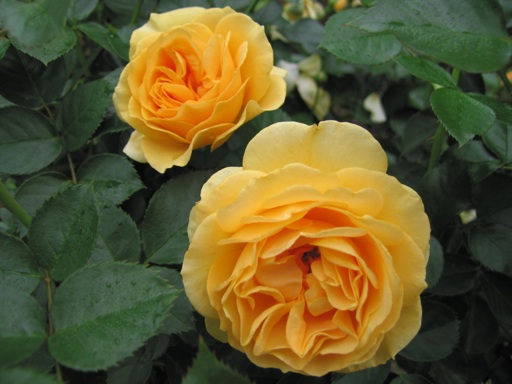
The growing seasons is largely over here in Northern California. As of mid-November, our roses are no longer growing new buds, but the buds that developed on our rose bushes in October are continuing to open this month.
This photograph shows a few of the flowers that are open on our Julia Child floribunda rose bush. The flowers of this rose have an eye-catching pale orange color and a mildly sweet candy smell that is very different from the typical rose smell. The flowers resemble an English rose in terms of their shape and petal pattern. Like many other floribunda roses, our Julia Child rose tends to produce many more flowers than a hybrid tea, although its flowers are smaller than the flowers of a hybrid tea rose.
We planted our Julia Child rose bush in our garden about 2 years ago, and it has doubled in size since then. This rose has a bushy growing habit. Rather than growing a few long canes like a hybrid tea rose, it grows lots of short stems and lots of glossy leaves that give the bush a filled-out rounded shape. However, its flowers are not ideal for cutting, because their stems are so short.
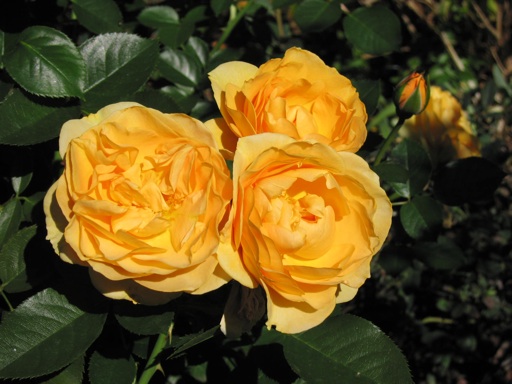
November 10 2008 | Roses | Comments Off on Julia Child Roses Still Opening
« Prev - Next »











